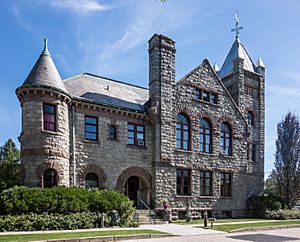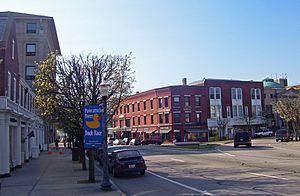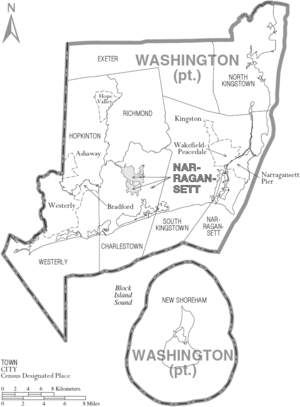Washington County, Rhode Island facts for kids
Quick facts for kids
Washington County
|
|
|---|---|

Former Washington County Courthouse in West Kingston
|
|
| Country | |
| State | |
| Region | New England |
| Metro area | Providence |
| Formed | June 3, 1729 |
| Named for | George Washington |
| County town | South Kingstown |
| Largest town | South Kingstown |
| Incorporated municipalities | 9 towns |
| Area | |
| • Total | 563 sq mi (1,460 km2) |
| • Land | 329 sq mi (850 km2) |
| • Water | 234 sq mi (610 km2) 41%% |
| Highest elevation | 567 ft (173 m) |
| Lowest elevation | 0 ft (0 m) |
| Population | |
| • Total | 129,839 |
| • Density | 230/sq mi (90/km2) |
| GDP | |
| • Total | $8.636 billion (2022) |
| Time zone | UTC−5 (EST) |
| • Summer (DST) | UTC−4 (EDT) |
| ZIP Code format |
028xx
|
| Area code | 401 |
| FIPS code | 44-009 |
| GNIS feature ID | 1219782 |
| Congressional district | 2nd |
Washington County, also called South County, is a county in the state of Rhode Island. In 2020, about 129,839 people lived there. Unlike counties in many other states, Rhode Island counties do not have their own governments. They mainly help organize the state's court system.
Contents
History of Washington County
The land that is now Washington County was once the home of the Narragansett Indian Tribe. In the late 1600s, English settlers from Newport and Massachusetts started farms here. Some of these large farms were known as "Narragansett Planters."
By the mid-1700s, there were many big farms in the county. The owners of these farms became very rich. People who were forced to work on these farms were enslaved. It is thought that between 15% and 25% of the county's population at that time were enslaved people.
Washington County was first named Kings County in 1729. This was when it was part of the Colony of Rhode Island and Providence Plantations. On October 29, 1781, its name was changed to Washington County. This was done to honor George Washington, a very important leader.
Before it was called Kings County, the area was known as "The Narragansett Country." It was named after the Narragansett and Niantic tribes who lived there. Early trading posts were set up in places like Fort Neck in Charlestown and Smith's Castle in Wickford.
For almost 100 years, the borders of the Narragansett Country were argued over. The colonies of Rhode Island, Connecticut, and Massachusetts all claimed parts of the land. In 1664, King Charles II helped settle these arguments. Rhode Island was given control of the area. Many towns in the county, like Kingstown and Charlestown, were named to honor King Charles II.
Today, Washington County is often called "South County" by local people. Sometimes, this name also includes towns outside Washington County, like East Greenwich.
Geography of Washington County
Washington County covers about 563 square miles. About 329 square miles of this is land, and 234 square miles (41%) is water. It is the largest county in Rhode Island by total area. The land is mostly flat near the coast. Farther inland, there are gently rolling hills. The highest point is about 560 feet above sea level in Exeter. The lowest point is sea level along the coast.
Protected Natural Areas
- Block Island National Wildlife Refuge
- John H. Chafee National Wildlife Refuge
- Ninigret National Wildlife Refuge
- Trustom Pond National Wildlife Refuge
Main Roads
 I-95
I-95 US 1
US 1 Route 1A
Route 1A Route 2
Route 2 Route 3
Route 3 Route 4
Route 4 Route 78
Route 78 Route 91
Route 91 Route 102
Route 102 Route 108
Route 108 Route 110
Route 110 Route 112
Route 112 Route 138
Route 138 Route 165
Route 165 Route 216
Route 216 Route 402
Route 402 Route 403
Route 403
People of Washington County
| Historical population | |||
|---|---|---|---|
| Census | Pop. | %± | |
| 1790 | 18,323 | — | |
| 1800 | 16,135 | −11.9% | |
| 1810 | 14,962 | −7.3% | |
| 1820 | 15,687 | 4.8% | |
| 1830 | 15,411 | −1.8% | |
| 1840 | 14,324 | −7.1% | |
| 1850 | 16,430 | 14.7% | |
| 1860 | 18,715 | 13.9% | |
| 1870 | 20,097 | 7.4% | |
| 1880 | 22,495 | 11.9% | |
| 1890 | 23,649 | 5.1% | |
| 1900 | 24,154 | 2.1% | |
| 1910 | 24,942 | 3.3% | |
| 1920 | 24,932 | 0.0% | |
| 1930 | 29,334 | 17.7% | |
| 1940 | 32,493 | 10.8% | |
| 1950 | 48,542 | 49.4% | |
| 1960 | 59,054 | 21.7% | |
| 1970 | 83,586 | 41.5% | |
| 1980 | 93,317 | 11.6% | |
| 1990 | 110,006 | 17.9% | |
| 2000 | 123,546 | 12.3% | |
| 2010 | 126,979 | 2.8% | |
| 2020 | 129,839 | 2.3% | |
| U.S. Decennial Census 1790-1960 1900-1990 1990-2000 2010-2019 |
|||
In 2010, there were 126,979 people living in Washington County. They lived in 49,177 households, and 32,297 of these were families. The county had about 385 people per square mile. Most people (93.8%) were white. Other groups included Asian (1.6%), Black or African American (1.2%), and American Indian (0.9%). About 2.4% of the population was of Hispanic or Latino background.
Many people in the county have ancestors from different parts of the world. The largest groups of ancestry include:
- 27.8% Irish
- 21.4% Italian
- 19.9% English
- 11.4% French
- 10.8% German
- 4.9% Portuguese
- 4.8% Polish
- 4.3% French Canadian
- 3.5% Scottish
- 2.9% Swedish
- 2.7% American
- 2.5% Scotch-Irish
- 1.4% Russian
About 28.6% of households had children under 18 living there. The average household had 2.45 people. The average age of people in the county was 42.3 years old. The average income for a household was $70,285. About 7.4% of the population lived below the poverty line. This included 6.3% of those under 18.
Communities in Washington County
Towns
- Charlestown
- Exeter
- Hopkinton
- Narragansett
- New Shoreham
- North Kingstown
- Richmond
- South Kingstown (This is the main county town)
- Westerly
Census-Designated Places (CDPs)
These are areas that are like towns but are not officially incorporated as towns.
Other Villages
These are smaller communities within the towns.
- Alton
- Arcadia
- Ashaway
- Barberville
- Bethel
- Burdickville
- Canonchet
- Centerville
- Davisville
- Galilee
- Hamilton
- Hopkinton City
- Jerusalem
- Kenyon
- Lafayette
- Locustville
- Matunuck
- Moscow
- Peace Dale
- Point Judith
- Rockville
- Saunderstown
- Shannock
- Shelter Harbor
- Slocum
- Usquepaug
- Wakefield
- West Kingston
- White Rock
- Wickford
- Wood River Junction
- Woodville
See also
 In Spanish: Condado de Washington (Rhode Island) para niños
In Spanish: Condado de Washington (Rhode Island) para niños



